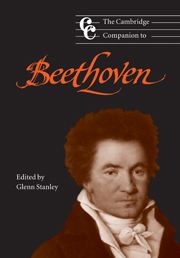Book contents
- Frontmatter
- Part I A professional portrait
- 1 Some thoughts on biography and a chronology of Beethoven's life and music
- 2 Beethoven at work: musical activist and thinker
- 3 The compositional act: sketches and autographs
- Part II Style and structure
- Part III Genres
- Part IV Reception
- Notes
- Selected further reading
- General index
- Index of Beethoven’s compositions and sketches
- Plate section
3 - The compositional act: sketches and autographs
from Part I - A professional portrait
Published online by Cambridge University Press: 28 September 2011
- Frontmatter
- Part I A professional portrait
- 1 Some thoughts on biography and a chronology of Beethoven's life and music
- 2 Beethoven at work: musical activist and thinker
- 3 The compositional act: sketches and autographs
- Part II Style and structure
- Part III Genres
- Part IV Reception
- Notes
- Selected further reading
- General index
- Index of Beethoven’s compositions and sketches
- Plate section
Summary
One of the best-known features of Beethoven's composing activity is his enormous efforts and struggle to produce his great masterpieces, in contrast to Mozart, who is reputed to have composed with great facility, working everything out in his head. Abundant evidence for Beethoven's struggles comes from his numerous sketchbooks, which were sufficiently prominent and unusual to draw forth comment from several eyewitnesses who wrote accounts of him. For example, Ignaz von Seyfried reported: “He was never found on the street without a small note-book in which he was wont to record his passing ideas.” Although Beethoven is not the only composer to have used sketchbooks, he seems to have been the first to have done so in any kind of systematic way, and almost no other composer has devoted such a large proportion of his time to refining his initial ideas through sketching processes.
Beethoven's propensity for making rough drafts and sketches for his works began almost as soon as he started composing as a boy. Moreover, one of his first published works – a set of three piano sonatas of 1783 (WoO 47) – contains a number of handwritten amendments in the printed score he owned, which are not merely corrections but subtle refinement of such things as articulation marks. Such close attention to detail, and an incessant desire to seek improvement on his existing ideas, were elements that remained with him throughout his life, and gave the impetus to increasingly elaborate methods of sketching.
- Type
- Chapter
- Information
- The Cambridge Companion to Beethoven , pp. 32 - 42Publisher: Cambridge University PressPrint publication year: 2000



